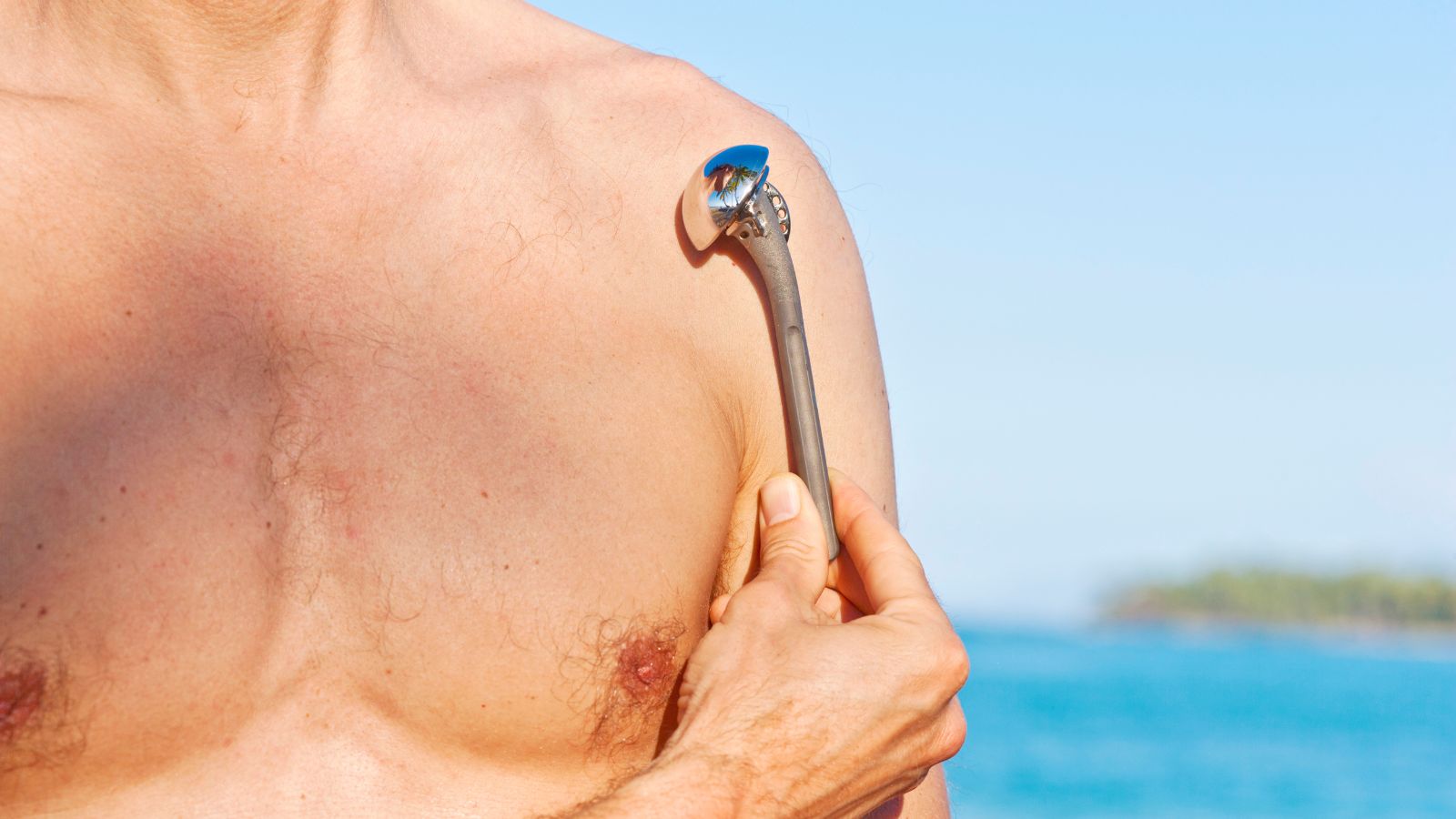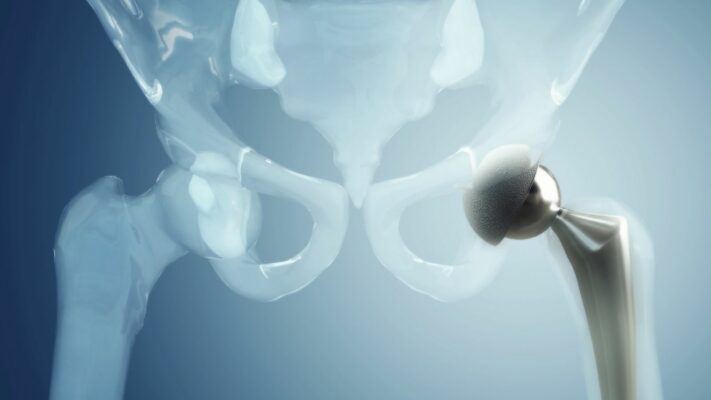Prof. Dr. Murat Demirel, one of the best orthopedic doctors performing shoulder replacement surgery in Ankara, offers modern and permanent solutions in cases of advanced shoulder arthritis, fractures, or severe damage to the joint surfaces. Shoulder replacement surgery is an advanced surgical method that aims to eliminate pain and restore mobility by replacing the damaged joint surfaces with artificial prostheses. Among the hospitals in Ankara performing shoulder replacement surgery, Prof. Dr. Demirel provides patient-specific surgical plans in centers equipped with advanced medical technology and high hygiene standards.
Before surgery, Prof. Dr. Demirel performs comprehensive evaluations to determine the most suitable prosthesis type and surgical technique, and he closely monitors his patients after the procedure. With post-operative recommendations, he ensures a safe, fast, and long-lasting recovery process. In addition, he provides transparent and up-to-date information on shoulder replacement surgery costs in Ankara, helping his patients make informed decisions. You can also contact us immediately to regain your shoulder health and improve your quality of life by scheduling an appointment.
| Surgery Name | Shoulder Replacement (Total or Reverse Shoulder Arthroplasty) |
| Application Area | Shoulder joint (humeral head and glenoid cavity) |
| Purposes of Use | Advanced shoulder osteoarthritis, severe shoulder fractures, avascular necrosis, rotator cuff arthropathy |
| Surgical Method | Open surgery; replacement of shoulder joint surfaces with prosthetic components |
| Type of Anesthesia | General anesthesia |
| Operation Duration | Approximately 1.5–2 hours |
| Hospital Stay | Usually 2–4 days |
| Recovery Process | 3–6 months; passive exercises in the early stage, followed by active rehabilitation |
| Complications | Infection, prosthesis loosening, shoulder dislocation (in reverse prosthesis), nerve damage, stiffness |
| Advantages | Pain relief, improved shoulder function, enhanced quality of life |
| Alternative Methods | Conservative treatment (physical therapy, medications, injections), shoulder arthroscopy |
| Suitable Patient Profile | Patients with advanced shoulder pain and limited mobility who do not benefit from conservative treatment |


Prof. Dr. Murat Demirel
Orthopedics and Traumatology Specialist
Orthopedics Specialist Prof. Dr. Murat Demirel was born in Ankara in 1974. He completed his primary education at Ankara Kavaklıdere Primary School and his secondary and high school education at Ankara Atatürk Anatolian High School. Dr. Demirel graduated from Ankara University Faculty of Medicine in 1998 and completed his residency in Orthopedics and Traumatology at Ankara Numune Training and Research Hospital, 1st Orthopedics and Traumatology Clinic, in 2004.
PhD
Ankara University Institute of Health Sciences
Specialization
Ankara Numune Training and Research Hospital, 1st Orthopedics Clinic
Medical School
Ankara University Faculty of Medicine
Yazı İçeriği
What Are Shoulder Prostheses and Why Are They Necessary?
Shoulder replacement surgery can be compared to replacing a worn-out car tire with a new, high-performance one. In this surgical procedure, the damaged bone surfaces forming the shoulder joint—namely the ball-shaped head of the upper arm bone and the shallow socket of the shoulder blade—are replaced with specially designed artificial components (prostheses). These prostheses are usually made of highly durable metal alloys (for the ball part) and a medical-grade plastic called polyethylene (for the socket part). The main goal of the surgery is simple: to eliminate persistent pain and maximize shoulder mobility, thereby improving the patient’s quality of life.
So, what leads a person to shoulder replacement surgery? This is usually the final step in a long process that develops gradually and eventually becomes unbearable. The main reasons are:
- Osteoarthritis
- Rheumatoid Arthritis
- Rotator Cuff Tear Arthropathy
- Post-traumatic Arthritis or Complex Fractures
- Avascular Necrosis
- Failed Previous Surgeries
Osteoarthritis, commonly known as wear-and-tear arthritis, is the leading cause. Over the years, the smooth cartilage tissue that covers the joint and allows bones to glide over one another wears down and thins. When the cartilage is completely gone, “bone-on-bone” friction begins. Patients often describe this as feeling like “sand in my shoulder” or “two stones grinding together,” which causes severe pain and a catching sensation during movement.
In inflammatory rheumatic conditions such as Rheumatoid Arthritis, the problem is different. Here, the body’s own immune system mistakenly attacks the joint lining, causing chronic inflammation, erosion of cartilage and bone, and eventually severe pain, swelling, and deformities.
Rotator Cuff Tear Arthropathy is a special condition we can now treat more successfully with the development of reverse shoulder prostheses. When the rotator cuff, the muscle-tendon group that stabilizes and moves the shoulder, is irreparably torn, the balance of the joint is disrupted. The humeral head shifts upward abnormally, causing friction that, over time, leads to arthritis, severe pain, and an inability to lift the arm (pseudo-paralysis). Shoulder replacement provides a definitive solution in these cases.
Sometimes, the reason is trauma. Multi-fragment fractures near the shoulder joint, impaired bone circulation, or improperly healed fractures can cause arthritis years later. In elderly patients, complex fractures may require primary treatment with prosthesis from the beginning.
Avascular Necrosis is a less common but serious condition in which blood vessels supplying the humeral head are blocked, leading to bone tissue death and collapse. This results in joint surface damage and severe pain. Finally, failed fracture surgeries or unsuccessful prostheses may also require revision surgeries to replace and correct the joint with a new prosthesis.
What Are the Different Types of Shoulder Prostheses and How Is the Choice Made?
Each patient’s shoulder problem is unique. Just like a tailor makes a custom suit, we surgeons choose the prosthesis that best suits the patient’s condition. The most decisive factor in this choice is usually whether the rotator cuff muscles are healthy or not. There are three main types of shoulder prostheses.
Anatomic Total Shoulder Prosthesis
This prosthesis, as the name suggests, exactly imitates the natural anatomical structure of the shoulder. The worn humeral head (ball) is replaced with a metal head; the worn glenoid (socket) is replaced with a polyethylene surface. For this prosthesis to work properly, the rotator cuff muscles, which are considered the motor of the shoulder, must be intact and functional. These muscles provide the movement and stability of the joint. It is most often preferred in advanced osteoarthritis (arthritis) patients with an intact rotator cuff. The goal is to relieve pain and restore shoulder movements as close to normal as possible.
Reverse Total Shoulder Prosthesis
This prosthesis is a revolution in shoulder surgery and its design is quite ingenious. It works with the exact opposite logic of the anatomic prosthesis: a socket is placed on the humerus, which normally has a ball, and a ball is placed on the scapula, which normally has a socket. So, what does this “reverse” design achieve? In this way, the task of the rotator cuff muscles, which no longer function or are completely torn, is transferred to the largest and strongest muscle of the shoulder, the deltoid muscle. Thanks to this new mechanical arrangement, the deltoid muscle can lift the arm by itself. Therefore, it is the gold standard solution for patients with irreparable “rotator cuff tear arthropathy.” It also plays a life-saving role in failed previous surgeries, complex elderly fractures, and cases with severe bone loss.
Partial Shoulder Prosthesis (Hemiarthroplasty)
In this method, only one side of the joint, the damaged head (ball) of the humerus, is replaced. The natural socket (glenoid) of the scapula is preserved. For this option to be considered, the cartilage on the socket side must be relatively healthy. Its most common use is in multi-part fractures of the humeral head that cannot be treated otherwise. The fracture fragments are removed and replaced with a prosthetic head. It may also be an option in young and active patients where arthritis is only in the ball part, while the glenoid is intact. Although it is a more protective method compared to total prosthesis, over time, wear may also occur on the preserved socket surface, causing pain.
Who Is Considered a Suitable Candidate for Shoulder Replacement Surgery?
The decision for shoulder replacement surgery is a joint decision made with the patient. This is not a simple equation like “I have pain, so I will immediately have surgery.” There are some important criteria to determine whether a person is a suitable candidate for this surgery. These criteria generally include:
- Severe shoulder pain that disrupts daily life
- Pain that wakes you up at night and does not improve with rest
- Progressive loss of motion and weakness in the shoulder
- Other treatment methods no longer being effective
In addition, the general health condition of the candidate must be at a level to withstand this major surgery. However, some conditions may prevent a person from being a suitable candidate. These conditions, which we can consider as red flags, are:
- Presence of an active infection anywhere in the body
- Dysfunction or paralysis of the deltoid muscle in the shoulder
- Advanced neurological diseases
- Inability to comply with the post-operative rehabilitation program
- Uncontrolled serious additional health problems
- Insufficient bone stock in the area where the prosthesis will be placed
Smoking is also an important factor. Smoking constricts blood vessels, reducing blood flow to tissues. This both delays wound healing and significantly increases the risk of infection. Therefore, patients planned for surgery are asked to quit smoking at least a few months before the operation. This is as important for the success of the surgery as the surgeon’s skill.
Contact us for detailed information and an appointment!
How Does the Preoperative Evaluation Process for Shoulder Replacement Surgery Work?
Once the decision for surgery is made, a meticulous evaluation process begins to prepare you for the operation in the safest way. This process focuses not only on your shoulder but also on your overall health.
The first step is a detailed medical history and physical examination. We talk with you extensively to understand the nature of your complaints, how long they have been ongoing, how they affect your life, and what your expectations are. We learn about all the medications you use, any allergies you may have, and other medical conditions such as diabetes or heart disease. Then, by carefully examining your shoulder, we assess the range of motion, muscle strength, stability, and painful areas.
The second step is imaging tests. Usually, the following tests are requested:
X-ray: This is a basic test to see the condition of the bones, the degree of arthritis, and the overall structure of the joint.
Magnetic Resonance Imaging (MRI): It allows us to evaluate in detail the condition of the rotator cuff muscles, tendons, and other soft tissues, which play a key role in selecting the prosthesis type.
Computed Tomography (CT): This very valuable method is used especially in cases where bone quality or quantity is insufficient, where there is significant wear in the glenoid (socket), or in complex cases with previous surgery, to view the bone structure in three dimensions and plan the surgery in every detail.
The third step is a general health check before surgery. It should be remembered that surgery is a stress for your body. Certain preparations are made to ensure that you can safely overcome this stress. These include:
- Blood tests
- Chest X-ray
- Electrocardiogram (ECG)
- Examination by the anesthesiologist
- Consultation from cardiology or other specialties if necessary
Finally, perhaps the most surprising but one of the most important steps is the dentist examination. An untreated cavity or gum infection in the mouth can enter the bloodstream, settle in the newly implanted prosthesis, and cause serious joint infections that are very difficult to treat. For this reason, we require all shoulder replacement candidates to undergo a dental check-up before surgery to ensure that their oral hygiene is excellent.
What Are Your Responsibilities in Preparing for Shoulder Replacement Surgery?
The success of surgery is a team effort, and the most important member of this team is you. There are some preparations you need to make until the day of the operation.
First of all, you need to regulate your medications. If you are taking blood-thinning drugs, we make a plan together with your cardiologist or internal medicine specialist regarding when and how to stop them. Aspirin, some painkillers, and supplements such as fish oil, which can thin the blood, should also be stopped 1–2 weeks before surgery.
Preparing your home for the post-operative period will also make your recovery process much more comfortable. Since your arm will be in a sling for a while after surgery and you will be using only one arm, some practical adjustments will be life-saving. Here are some preparations you can make at home:
- Place frequently used kitchen utensils, remote control, and phone in easily accessible low areas.
- Prepare a few days’ worth of meals that can be easily reheated and store them in the refrigerator.
- Remove rugs, coffee tables, or floor cables that may cause you to trip and fall.
- Put a non-slip mat in the bathroom and maybe install a grab bar.
- Prepare loose clothing with front buttons or zippers that are easy to put on and take off.
The list of things you need to bring to the hospital is also quite simple. Leave your valuables at home. It will be enough to bring only your personal care items, comfortable clothes, and a relative to accompany you.
How Is Shoulder Replacement Surgery Performed Technically?
Shoulder replacement surgery is performed by an experienced surgical team in a modern operating room and usually takes 1.5 to 2 hours. It is generally performed under general anesthesia so that you feel nothing and remember nothing throughout the procedure. In addition, a regional anesthesia technique (nerve block), in which the nerves going to the arm are numbed with an injection, may be applied to make the first 12–24 hours after surgery much more comfortable.
The surgery begins with an incision of about 8–10 cm made at the front of the shoulder. The surgeon carefully separates the muscle layers to reach the shoulder joint. To access the joint, the subscapularis tendon, one of the rotator cuff muscles, is surgically detached from its attachment to the bone and is later reattached with very strong stitches at the end of the procedure. Proper healing of this tendon is vital for the stability and function of the shoulder after surgery.
Once the joint is reached, the worn and damaged humeral head (ball) is cut and removed. Then, the stem part of the chosen prosthesis is placed into the cavity inside the bone. The glenoid (socket) of the scapula is smoothed using special tools, and a polyethylene (plastic) socket component is usually fixed with a special filling material called bone cement. If a reverse prosthesis is being performed, the opposite steps are applied; a metal ball is placed into the socket, and a plastic socket is placed into the humerus.
After all prosthetic components are placed, the joint’s movements, stability, and compatibility are repeatedly checked. Once everything is confirmed to be in order, the subscapularis tendon is reattached, and the muscle layers and skin are closed, completing the surgery.
What Is the Recovery and Rehabilitation Journey After Shoulder Replacement Surgery?
The most challenging part of the surgery may be over, but the real recovery journey is just beginning. This process is a marathon that requires patience, determination, and your active participation over weeks and months.
First 24–48 Hours (Hospital Stay): When you wake up from surgery, your arm will be in a special sling (shoulder bandage). This sling will be your closest companion to protect the repaired tissues and must be worn continuously, especially at night and when going outside, usually for the first 4–6 weeks. Your pain will be controlled with strong painkillers given intravenously or orally. From the very first day, a physiotherapist will come to show you some simple exercises you need to do, such as:
- Opening and closing the wrist and fingers
- Bending and extending the elbow (without removing the sling)
- Making a fist and releasing it frequently
These movements are very important to increase blood circulation, reduce the risk of clots, and prevent muscle inactivity. Usually, staying in the hospital for 1 or 2 nights is sufficient.
First 6 Weeks (Protection and Passive Motion Period): This is the most critical phase of recovery. At home, you should regularly perform the exercises shown by your doctor and physiotherapist (especially pendulum exercises) several times a day. The most important rule during this period is not to use your operated arm actively. In other words, you should not try to lift your arm with your own muscle strength. The absolute restrictions during this period include:
- Lifting anything heavier than a teacup
- Pushing or pulling with your arm
- Using your operated arm to support yourself while getting out of bed or a chair
- Sudden sideways or backward twisting of the arm
Weeks 6 to 12 (Active Motion and Strengthening Period): At your 6th-week follow-up, once it is confirmed by X-ray that everything is in order, you can move on to the next stage of rehabilitation. You can gradually stop using the sling. You can now start moving your arm with your own muscle power. Under the guidance of a physiotherapist, a more comprehensive exercise program is started to improve your range of motion and gradually strengthen the muscles. Exercises with light resistance bands form the basis of this period.
After 3 Months (Return to Function): At this stage, your shoulder strength and movements have significantly improved. You can perform most daily activities comfortably. With your doctor’s approval, you can gradually return to sports activities that do not put excessive strain on the shoulder, such as swimming, table tennis, and light walking. However, full strength and function may take 6 months to 1 year to achieve. Patience and adherence to your exercise program are the keys to success during this period.
Contact us for detailed information and an appointment!
Frequently Asked Questions
Is shoulder replacement surgery risky?
Like any surgical procedure, shoulder replacement also has some risks, but these are quite low. The most common ones we encounter are infection, vascular or nerve injury, and dislocation of the prosthesis. With detailed preoperative planning, modern surgical techniques, and good postoperative care, we minimize these risks. Don’t worry, together with our team, we take all the necessary precautions to make the process as safe as possible for you.
How long does a shoulder prosthesis last?
Modern shoulder prostheses produced with today’s technology are highly durable. A prosthesis placed with the correct surgical technique and used with care to protect your shoulder usually lasts over 20 years. If wear occurs after this period, it is usually possible to replace the worn part with a simpler operation. Our goal is to help you live a pain-free and comfortable life for many years.
How many days does it take to recover from shoulder replacement?
Although recovery varies from person to person, we generally have a standard timeline. The first few weeks after surgery are the most critical. By about 6 weeks, you can stop using the sling and return to simple daily tasks. Full strengthening of your shoulder and regaining the ability to perform all movements comfortably may take 4 to 6 months. Being patient and paying attention to physical therapy is the key to getting through this process successfully.
Can a shoulder prosthesis move out of place?
This is one of the most common concerns among our patients. Dislocation of the shoulder prosthesis is very rare. Thanks to the careful adjustments made during surgery and your adherence to the doctor’s instructions—especially movement restrictions in the first weeks—we almost eliminate this risk. Your prosthesis is placed firmly so you can use it safely.
How long does pain last after shoulder surgery?
It is completely normal to experience pain in the first few days after surgery. These pains are easily controlled with the effective painkillers we prescribe for you. Generally, by the time you are discharged from the hospital, your pain has already decreased significantly. In the following weeks, you may feel mild aches, but these will gradually disappear completely. Our aim is to manage this process for you as comfortably as possible.
How many days do you stay in the hospital after shoulder surgery?
The length of hospital stay after shoulder replacement surgery is usually quite short. If everything goes well, we plan to discharge you within 2 to 3 days after the surgery. During this period, we ensure that your pain is under control, your general condition is good, and you can safely return home.
How long does physical therapy last after shoulder surgery?
Physical therapy is just as important as the surgery itself for the success of the operation. Usually, shortly after surgery, we start a personalized exercise program for you. This program typically lasts around 3 to 6 months. With regular exercises performed under the supervision of a physiotherapist, we aim to maximize your shoulder’s range of motion and strength.
When can the sling be removed after shoulder surgery?
To protect your shoulder and aid recovery, you will use a sling after surgery. Depending on the type of surgery performed and the speed of your tissue healing, we usually ask you to wear it for 4 to 6 weeks. At the end of this period, with your doctor’s examination and approval, you will gradually stop using the sling and begin to use your shoulder more actively.




